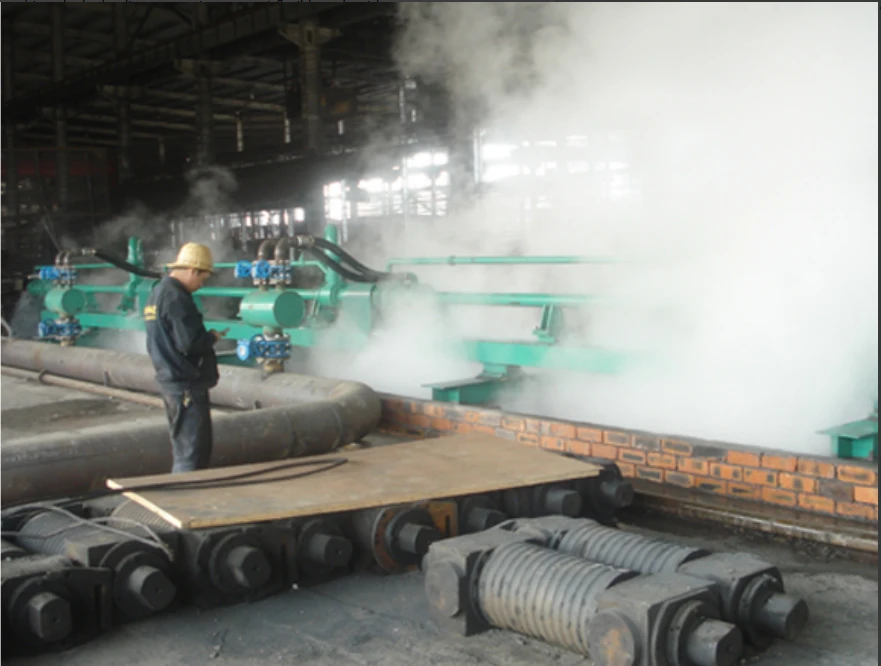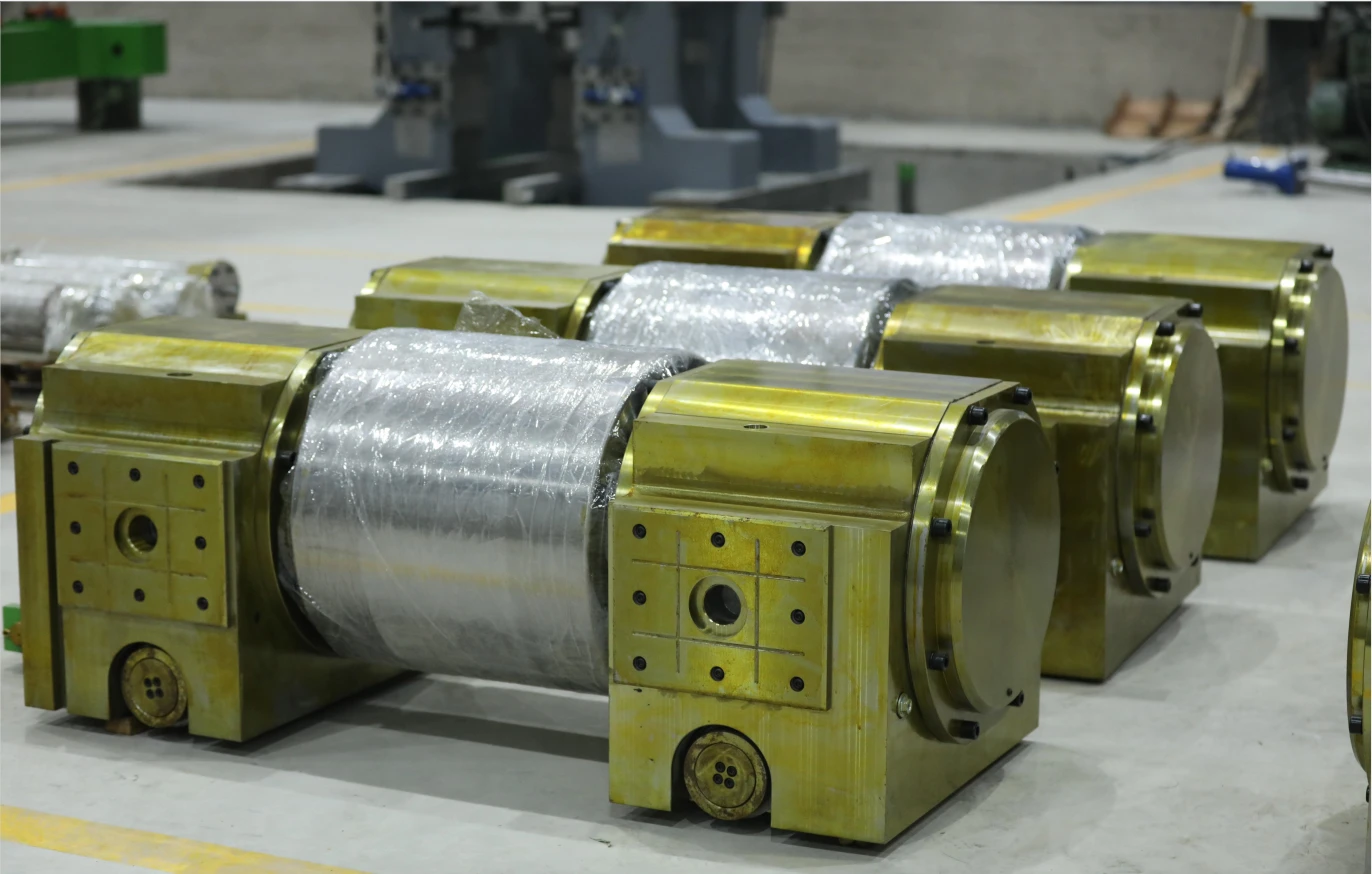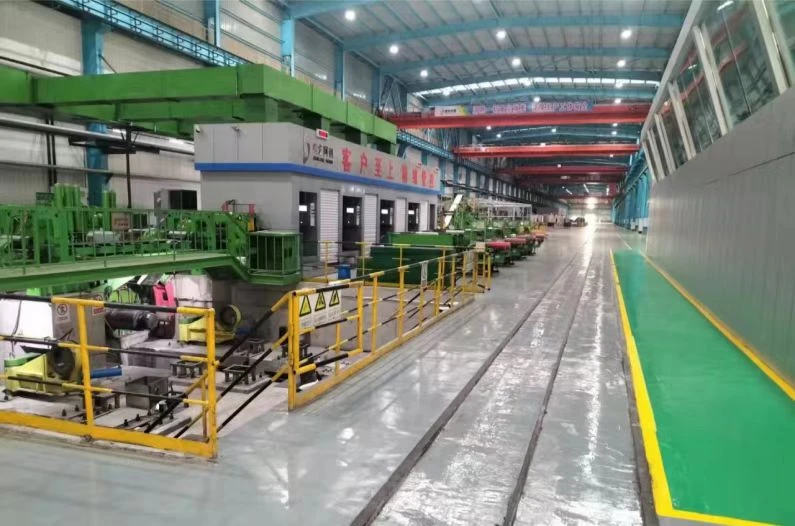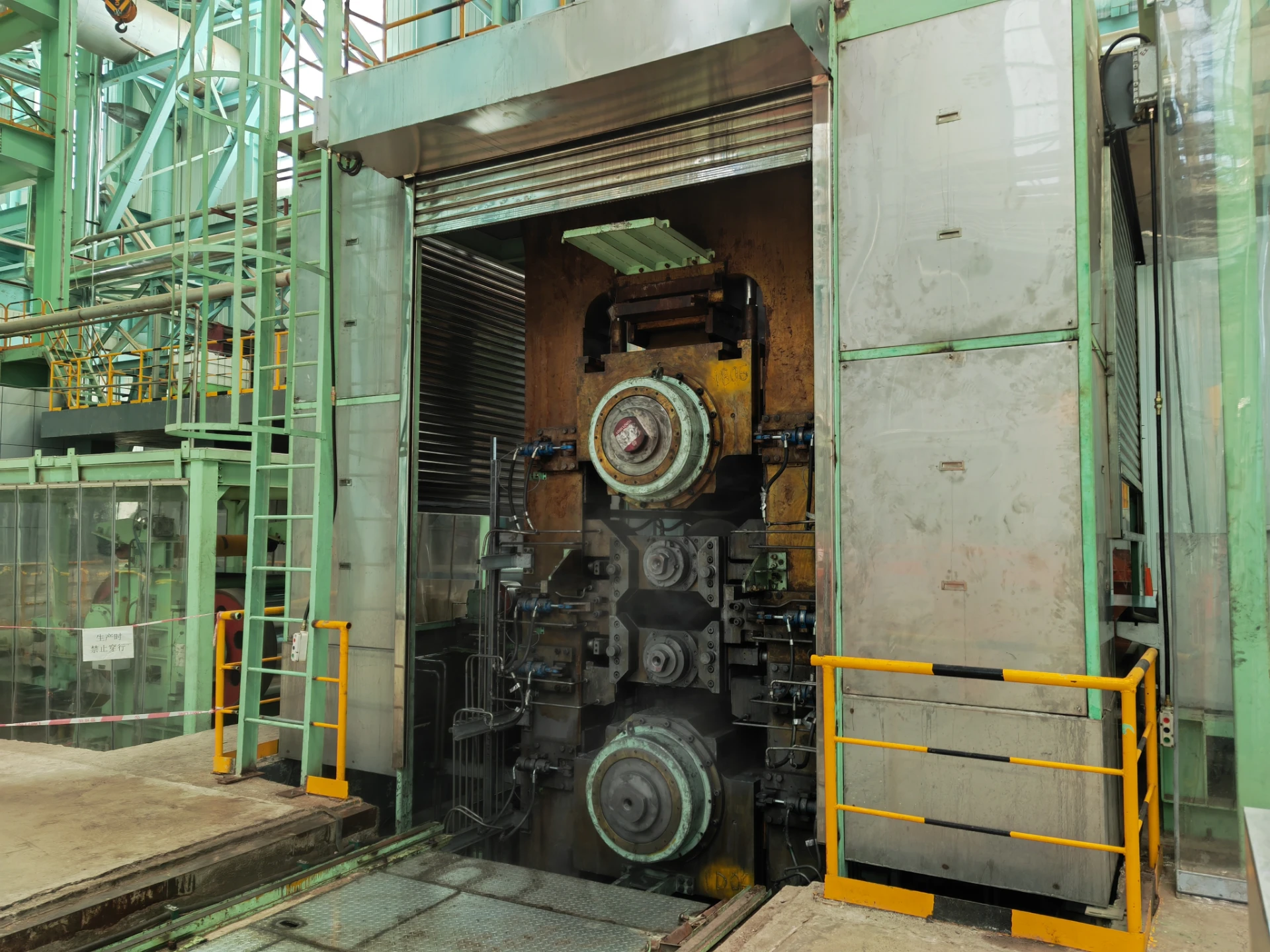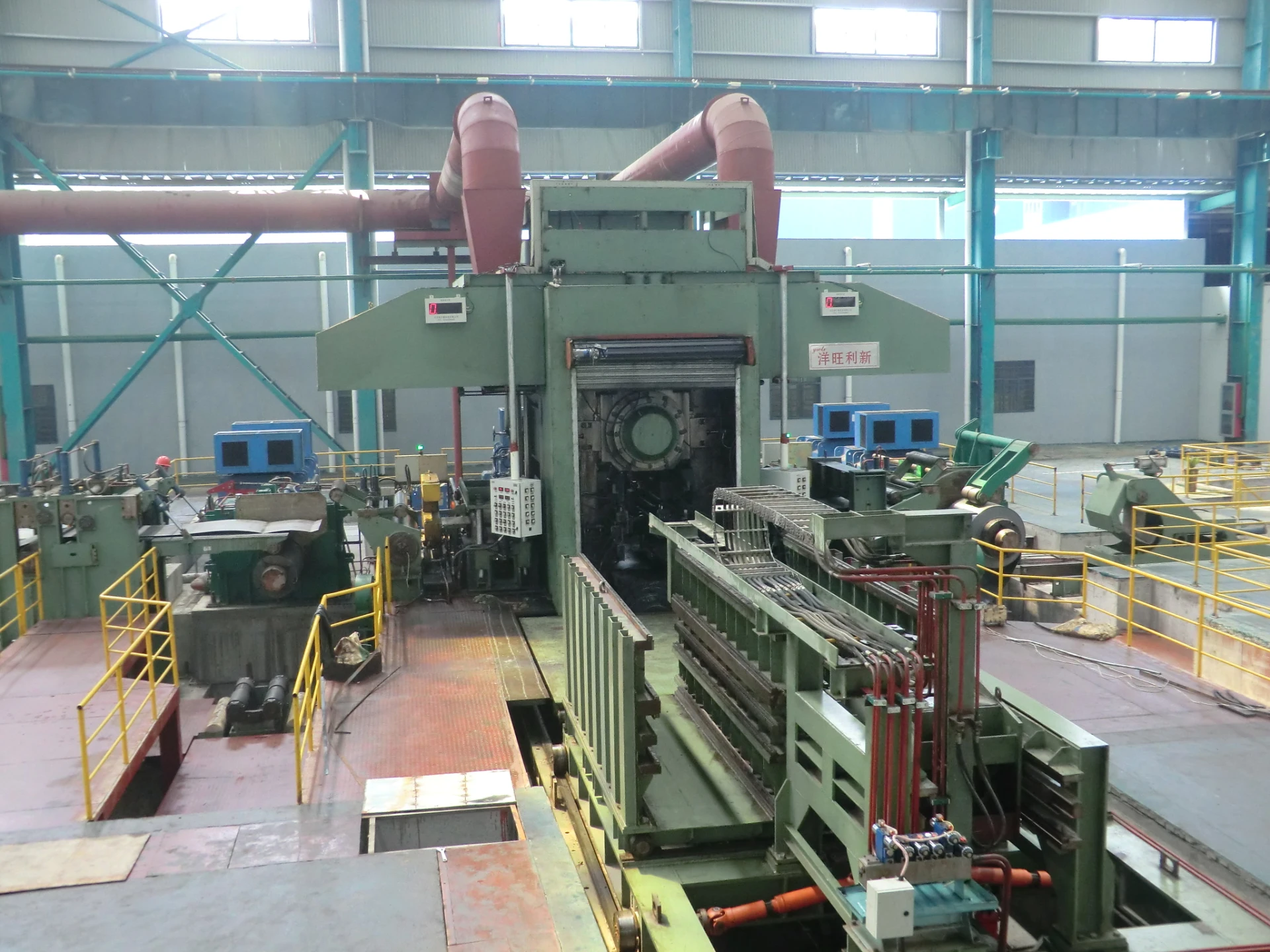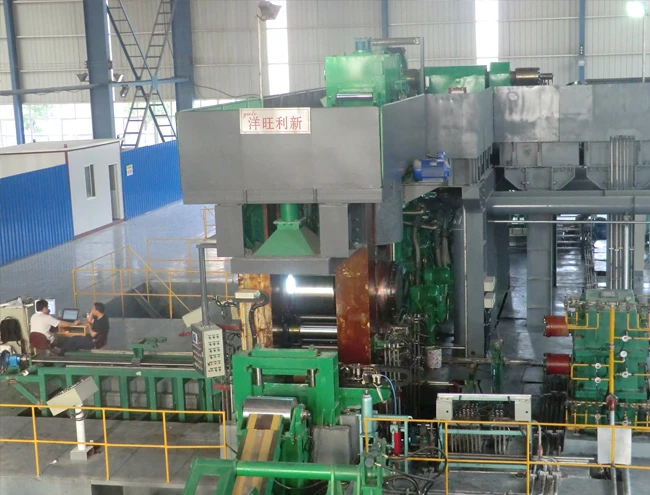
High-Efficiency Tandem Cold Mills for Precision Steel Rolling
Introduction to Tandem Cold Rolling Mill Technology: Precision in Metal Processing
In the intricate world of metal processing, the tandem cold mill stands as a cornerstone technology, indispensable for producing high-quality, thin-gauge metal strips with exceptional surface finishes and precise dimensional tolerances. This sophisticated machinery transforms hot-rolled coils into cold-rolled products by sequentially reducing their thickness through multiple rolling stands. The significance of a tandem cold mill extends across numerous industrial sectors, from the automotive industry, which demands lightweight yet strong materials for vehicle bodies, to the electronics sector, requiring ultra-thin precision foils for advanced components. The relentless pursuit of efficiency, accuracy, and material integrity drives continuous innovation in this field, pushing the boundaries of what is achievable in metal transformation. Modern tandem cold mills are characterized by their integration of advanced automation systems, sophisticated control algorithms, and robust mechanical designs, all working in concert to achieve unparalleled levels of performance. The inherent advantage of a tandem configuration lies in its ability to process material continuously through several reduction stages, resulting in significantly higher throughput compared to single-stand reversing mills. This continuous processing capability not only boosts productivity but also contributes to more uniform material properties and superior surface quality, crucial factors for demanding applications. The synergy between high-speed operation and meticulous process control ensures that the finished product meets the stringent specifications required by end-users, underscoring the vital role of the tandem cold mill in the global supply chain for flat metal products. Furthermore, the capacity for precise gauge control and flatness correction within a tandem setup allows for the production of specialized materials, such as high-strength low-alloy (HSLA) steels or electrical steels, each with unique metallurgical characteristics. The complexity of these mills necessitates a deep understanding of metallurgy, mechanical engineering, electrical systems, and automation, making their design, manufacturing, and operation a testament to advanced industrial engineering. The longevity and reliability of these assets are paramount, demanding the highest standards in component manufacturing, assembly, and subsequent maintenance, ensuring decades of continuous, high-volume production.
The Manufacturing Process of a Tandem Cold Mill: Engineering Excellence in Every Component
The construction of a modern tandem cold mill is an immense undertaking, a complex symphony of engineering disciplines that culminates in a highly robust and precise piece of industrial equipment. The manufacturing process begins with the careful selection of high-grade materials, specifically chosen for their exceptional strength, wear resistance, and dimensional stability under extreme operating conditions. Key structural components, such as the mill housings and roll chocks, are typically manufactured through advanced casting techniques. For example, large mill housings, which bear the immense rolling forces, are often cast from specialized high-strength ductile iron or steel, followed by meticulous annealing to relieve internal stresses and enhance toughness. This ensures that the framework of the mill can withstand pressures reaching thousands of tons while maintaining its structural integrity over decades of operation. Similarly, the work rolls and backup rolls, which are at the heart of the rolling process, undergo sophisticated forging procedures. These rolls, critical for precise tandem mill rolling, are forged from high-carbon, high-chromium tool steels or specialized forged steel alloys to achieve superior hardness and wear resistance. The forging process compacts the material, refines its grain structure, and eliminates internal defects, resulting in rolls capable of enduring millions of tons of steel processing without significant deformation or degradation. Following casting and forging, precision machining becomes paramount. Using state-of-the-art CNC (Computer Numerical Control) machining centers, components like roll necks, bearing seats, and mill screwdowns are machined to incredibly tight tolerances, often measured in micrometers. This ensures precise alignment, smooth operation, and minimal vibration during high-speed rolling. The intricate geometries and stringent surface finish requirements demand multi-axis machining capabilities and expert programming. Heat treatment is another critical stage, particularly for components exposed to high stresses or friction. Rolls undergo specialized heat treatments, such as induction hardening or deep cryogenic treatment, to enhance their surface hardness and core toughness, thereby extending their operational life. Similarly, gears, bearings, and other high-wear parts are precisely heat-treated to optimize their mechanical properties. Quality control and inspection are interwoven throughout every stage. Adherence to international standards such as ISO 9001 for manufacturing quality management is non-negotiable, alongside specific material standards like ASTM, EN, or JIS. Non-destructive testing (NDT) methods, including ultrasonic testing (UT) for internal flaws, magnetic particle testing (MPT) for surface cracks, and radiographic testing (RT) for volumetric defects, are routinely employed to ensure the integrity of critical components before assembly. Once individual components pass rigorous inspection, the complex process of assembly begins, involving the integration of mechanical, hydraulic, electrical, and automation systems. This phase requires skilled engineers and technicians to meticulously align massive parts, install sophisticated sensor arrays, and calibrate complex control loops. The final product is then subjected to extensive factory acceptance tests (FAT) to verify its operational parameters, safety features, and compliance with design specifications. The longevity and reliability of a tandem cold mill are directly proportional to the rigor applied during its manufacturing, reflecting a commitment to engineering excellence that underpins its capacity for continuous, high-volume production in diverse applicable industries such as metallurgy, petrochemicals (for specialized pipe production), and even in the context of large-scale water supply and drainage systems requiring robust steel components. The design inherently focuses on advantages like energy efficiency through optimized mechanical designs and anti-corrosion properties by selecting appropriate materials and surface treatments.
Core Technical Parameters and Operational Principles of Tandem Cold Mills
The operational efficiency and product quality delivered by a tandem cold mill are intricately linked to its core technical parameters and the sophisticated control systems that govern its process. At its heart, a tandem mill consists of a series of rolling stands, typically ranging from three to six, with five-stand configurations being highly common for producing various steel grades. Each stand progressively reduces the thickness of the metal strip, with the total reduction often exceeding 90% from entry to exit. Key parameters include the number of stands, which dictates the total achievable reduction and flexibility; the roll configurations, such as 4-high, 6-high, or 12-high mills, each offering specific advantages in terms of gauge control, flatness, and roll stability, particularly when rolling very thin or hard materials; and the maximum rolling speed, which can reach up to 2,000 meters per minute or more in high-capacity mills, directly impacting production throughput. The rolling force, measured in kilonewtons, exerted by each stand’s rolls on the strip is a critical parameter, precisely controlled by screw-down mechanisms, which are increasingly hydraulic (HAGC - Hydraulic Automatic Gauge Control) for faster response and higher accuracy compared to electric screw-downs (EAGC). HAGC systems use hydraulic cylinders to adjust the roll gap dynamically, compensating for variations in incoming strip thickness, roll eccentricity, and mill elasticity, thereby maintaining consistent exit gauge within tolerances as tight as ±2 microns.
Another crucial aspect is Automatic Flatness Control (AFC) systems, which are essential for producing perfectly flat strips, free from edge waves or center buckles. AFC mechanisms include work roll bending, intermediate roll bending (for 6-high mills), and segmented cooling, where jets of coolant are applied across the roll width to precisely control thermal expansion and shape. These systems actively adjust the roll profiles to counteract shape defects induced by differential elongation across the strip width. Interstand tension control is equally vital, as it ensures smooth material flow between stands and contributes significantly to stable rolling and gauge accuracy. Tensiometers precisely measure the tension, and advanced control loops adjust the speeds of successive stands to maintain optimal tension profiles. Lubrication and cooling systems are integral for maintaining roll life and preventing strip surface defects. Rolling oil, a specialized lubricant, not only reduces friction between the rolls and the strip but also acts as a coolant, dissipating the significant heat generated during plastic deformation. The efficient filtration and recirculation of rolling oil are paramount for maintaining surface quality and extending the life of the lubricant. Power consumption is substantial in these operations, with main drives typically ranging from several megawatts to tens of megawatts. Energy efficiency is a growing concern, addressed through optimized rolling strategies, advanced motor control systems (e.g., variable frequency drives), and regenerative braking systems. Overall, the interplay of these technical parameters and the sophisticated automation systems—often operating at Level 2 (process control) and Level 3 (production management) of automation—allows the tandem cold mill to achieve remarkable levels of precision and efficiency in the production of cold-rolled steel and other metal strips, making it a pivotal asset in modern metalworking. The continuous evolution of these technical aspects ensures that these mills remain at the forefront of material processing, meeting the ever-increasing demands for lighter, stronger, and more precise metal products across global industries.
Seamless Integration: The Critical Role of Pickling Line and Tandem Cold Mill Synergy
The efficiency and quality of cold-rolled products are profoundly impacted by the seamless integration of the pickling line and tandem cold mill. In modern steel production, these two formidable units are often linked in a continuous or semi-continuous process, forming a cohesive production chain that optimizes material flow, reduces inter-process handling, and significantly enhances the final product's surface quality and metallurgical properties. The pickling line is the crucial precursor, tasked with removing the scale (iron oxides) that forms on the surface of hot-rolled steel coils during their production. This scale, if not thoroughly removed, would be pressed into the strip surface during cold rolling, leading to unacceptable surface defects and premature wear on the mill rolls. Traditional batch pickling has largely been superseded by continuous pickling lines, which employ highly efficient turbulent acid baths (typically hydrochloric acid) followed by rinsing, drying, and often oiling. The integration begins here: a well-designed pickling line delivers a clean, rust-free, and uniformly surface-prepared strip directly to the entry of the tandem cold mill.
The benefits of this integrated approach are multifaceted. Firstly, it ensures a consistent supply of perfectly prepared material, eliminating the need for intermediate coil storage and handling, which reduces logistical costs and potential for damage. This streamlined material flow translates directly into higher overall throughput for the entire cold rolling complex. Secondly, the quality of the pickling process directly influences the surface quality of the cold-rolled product. A strip emerging from an optimally performing pickling line with a uniform, clean surface allows the tandem mill to achieve superior finishes, gloss, and texture, essential for demanding applications like automotive body panels or appliance casings. Thirdly, integrated lines often feature advanced tension levellers and edge trimmers within the pickling section, which can significantly improve strip flatness and width consistency before it even enters the rolling stands. This pre-treatment reduces the burden on the mill's Automatic Flatness Control (AFC) system and contributes to more stable rolling. Furthermore, in continuous lines, the speeds of the pickling and cold rolling sections are synchronized, with sophisticated buffer systems (e.g., entry and exit loopers) accommodating minor speed differentials. This synchronization minimizes downtime and maximizes the utilization of both high-value assets. The environmental considerations are also significant; integrated systems can more effectively manage and treat waste acids and process water from both operations, leading to improved compliance and reduced environmental footprint. The synergy between the pickling line and the tandem cold mill is not merely a logistical convenience but a fundamental design principle for achieving peak performance in modern flat metal production, showcasing how a holistic approach to process design yields superior product quality, higher efficiency, and greater sustainability.
Application Scenarios and Industry Trends Driving Tandem Cold Mill Evolution
The versatility and precision of the tandem cold mill make it indispensable across a myriad of industrial sectors, each with its unique demands for metal properties and dimensions. In the automotive industry, for example, tandem mills are crucial for producing high-strength, lightweight steel for car body panels, structural components, and chassis parts. The ability to achieve excellent formability and surface quality at high speeds is paramount, as these materials directly impact vehicle safety, fuel efficiency, and aesthetic appeal. The demand for advanced high-strength steels (AHSS) and ultra-high-strength steels (UHSS) continues to drive the evolution of tandem mill rolling technology, requiring mills capable of handling harder materials while maintaining precise gauge control. For the home appliance sector, from refrigerators and washing machines to ovens, cold-rolled steel provides the necessary strength, durability, and a smooth, paint-ready surface. The consistent thickness and flatness produced by tandem mills are critical for efficient manufacturing and assembly lines in this industry. In the construction industry, cold-rolled steel is used for various applications, including roofing, structural elements, and pre-engineered buildings, where its strength-to-weight ratio and ability to be easily formed into complex shapes are highly valued.
The packaging industry, particularly for tinplate and aluminum foil, relies heavily on tandem cold mills to produce extremely thin and uniform materials for food and beverage container111s. The precision required here is immense, as slight variations can impact sealing integrity or material usage. Beyond these major sectors, tandem cold mills also serve specialized markets like electrical steels (for transformers and motors, requiring specific magnetic properties), stainless steels (for corrosion resistance and aesthetic appeal in various applications), and precision alloys for electronics and aerospace.
Current industry trends are profoundly shaping the development of tandem cold mills. One dominant trend is the continuous push for thinner, wider, and higher-strength materials, which necessitates more robust mill stands, higher rolling forces, and more sophisticated control systems. Simultaneously, there's an accelerating trend towards increased automation and the integration of Artificial Intelligence (AI) and machine learning into mill operations. This involves using AI for predictive maintenance, optimizing rolling schedules, real-time defect detection, and fine-tuning control parameters for even greater precision and efficiency. Energy efficiency and sustainability are no longer secondary considerations but primary drivers. Modern mills are designed to minimize energy consumption through optimized drive systems, heat recovery, and efficient lubrication systems. The goal is to reduce the carbon footprint of steel production while maintaining or improving output. Digitalization, often referred to as Industry 4.0, is transforming mills into smart factories. This includes extensive sensorization, big data analytics, cloud connectivity, and the implementation of digital twins for real-time monitoring, simulation, and optimization. Predictive maintenance, enabled by IoT sensors and AI, allows for timely interventions, minimizing unplanned downtime and extending equipment life. Furthermore, there's a growing emphasis on flexibility in product mix, allowing mills to quickly switch between different material grades and dimensions to meet fluctuating market demands. This requires advanced roll change systems and highly adaptable control algorithms. These trends collectively underscore the dynamic evolution of tandem cold mill technology, ensuring its continued relevance and pivotal role in high-performance metal production globally.
Technical Advantages of Advanced Tandem Cold Rolling Mills in Modern Production
The technological advancements in tandem cold mill design have ushered in a new era of performance, offering a multitude of technical advantages that are critical for modern high-volume, high-quality metal production. One of the foremost benefits is the superior product quality achieved through precise control over gauge, flatness, and surface finish. Advanced Automatic Gauge Control (AGC) systems, particularly hydraulic AGC (HAGC), can maintain exit thickness tolerances within a few microns, even at high rolling speeds. This precision is vital for downstream processes and ensures material consistency for end-use applications, reducing waste and improving manufacturing efficiency. Coupled with sophisticated Automatic Flatness Control (AFC) systems, which integrate work roll bending, intermediate roll bending, and segmented roll cooling, these mills produce strips with exceptional flatness, free from undesirable shape defects like edge waves or center buckles. This eliminates the need for extensive post-rolling leveling and enhances the aesthetic and functional properties of the final product.
Another significant advantage is the remarkably high production efficiency and throughput. By continuously rolling the strip through multiple stands in tandem, these mills achieve significantly higher processing speeds and volumes compared to single-stand reversing mills. This continuous tandem mill rolling translates directly into increased productivity and lower per-unit production costs. The seamless flow, minimized threading times, and rapid coil changes contribute to maximizing operational uptime. Energy efficiency has also seen substantial improvements. Modern mills incorporate optimized drive systems, often employing high-efficiency variable frequency drives (VFDs) and regenerative braking, which can recover energy during deceleration. Intelligent control algorithms further optimize rolling schedules to minimize power consumption while achieving desired reductions. This not only reduces operational expenditures but also aligns with global sustainability goals.
Reduced operational costs are a direct outcome of several technical advancements. The robust design and high-quality manufacturing of components lead to extended service life and reduced maintenance requirements. Predictive maintenance strategies, enabled by IoT sensors and advanced analytics, allow for proactive interventions, minimizing unplanned downtime and expensive emergency repairs. Furthermore, automation reduces the reliance on manual labor, leading to lower labor costs and improved safety. Enhanced safety features are inherently built into contemporary tandem cold mill designs, including comprehensive interlocking systems, emergency stops, and advanced monitoring, protecting personnel during operation and maintenance. Finally, the flexibility in product mix and material types is a compelling advantage. Modern tandem mills are capable of processing a wide range of materials, including various grades of carbon steel, stainless steel, silicon steel, and even certain non-ferrous alloys, while producing a diverse array of finished dimensions, from wide, thick plates to ultra-thin foils. This adaptability allows manufacturers to respond swiftly to market demands and diversify their product offerings, making the investment in an advanced tandem cold mill a strategic decision for long-term competitive advantage.
Manufacturer Comparison and Custom Solutions for Tandem Cold Mills
The global landscape of tandem cold mill manufacturing is characterized by a few dominant players and numerous specialized providers, each bringing unique strengths and technological philosophies to the table. When considering an investment in such a substantial capital asset, a thorough comparison of manufacturers is essential, focusing not just on the initial cost but on long-term performance, reliability, technological innovation, and after-sales support. While specific company names are beyond the scope, it is illustrative to consider archetypes of manufacturers: some excel in producing heavy-duty mills for high-volume, mass production of standard grades, prioritizing robustness and sheer throughput. These manufacturers typically offer highly standardized configurations, optimized for maximum operational uptime and minimal maintenance in demanding environments. Their advantage often lies in their proven track record and extensive experience with large-scale projects.
Conversely, other manufacturers specialize in high-precision mills designed for challenging materials or ultra-thin gauges, such as those required for electrical steel or advanced automotive applications. Their differentiator is often the sophistication of their control systems—particularly in AGC and AFC technologies—and their ability to handle complex metallurgical challenges. They might employ unique roll configurations (e.g., 20-high mills) or advanced lubrication systems to achieve superior surface qualities and extreme thickness tolerances. A third category might focus on energy efficiency and sustainability, integrating cutting-edge drive technologies, waste heat recovery systems, and optimized rolling processes to minimize environmental impact and operational costs. Their value proposition centers around long-term savings and adherence to stringent environmental regulations. Key differentiators across all types of manufacturers include the sophistication of their control systems (Level 1, Level 2, Level 3 automation), the level of roll shop automation they offer (for rapid roll changes and grinding), their global service network, and their investment in research and development (R&D) to stay ahead of industry trends.
Beyond standardized offerings, the demand for custom solutions in the tandem cold mill market is significant. Clients often have unique requirements related to the specific material types they intend to roll (e.g., carbon steel, stainless steel, silicon steel, non-ferrous alloys), the desired product mix (e.g., wide strips, narrow strips, specific thickness ranges), desired production capacity, and even existing plant space constraints. Reputable manufacturers engage in a comprehensive consultation process, working closely with clients to understand their exact needs and challenges. This involves detailed engineering design, often utilizing advanced simulation software to model rolling processes and predict mill performance before physical construction begins. Customization can involve modifying the number of stands, optimizing roll diameters and materials, integrating specific types of AGC/AFC systems, tailoring coil handling equipment, and designing unique automation solutions to interface with existing plant infrastructure. Modular design approaches are increasingly common, allowing for future upgrades or expansions without requiring a complete mill overhaul. The project management capabilities of a manufacturer are also crucial for custom solutions, ensuring timely delivery, seamless installation, and efficient commissioning of these highly complex systems. Ultimately, choosing the right manufacturer for a tandem cold mill involves a deep dive into their technical capabilities, their track record in delivering similar projects, and their capacity for partnership in developing a tailored solution that maximizes return on investment and long-term operational success for the specific requirements of tandem mill rolling.
Detailed Product Specifications: Typical Tandem Cold Rolling Mill Parameters
Understanding the detailed product specifications of a tandem cold mill is crucial for prospective buyers and technical stakeholders seeking to optimize their production capabilities. These parameters define the mill's operational envelope, its capacity, and its ability to meet specific product quality requirements. Below is a comprehensive table outlining typical specifications for a state-of-the-art Tandem Cold Rolling Mill, such as a modern five-stand configuration, designed for high-precision steel processing. This data highlights the engineering precision and robust capabilities inherent in advanced rolling mill technology, offering insights into what can be achieved in terms of speed, force, and dimensional control. These specifications are dynamic and can be customized based on client requirements for specific material grades, desired output dimensions, and production volumes.
| Parameter | Description / Value Range |
|---|---|
| Mill Type | Tandem Cold Rolling Mill (e.g., 5-Stand, Four-High Configuration) |
| Number of Stands | Typically 3 to 6 stands; 5-Stand for balanced reduction and speed. |
| Max Strip Width | 800 mm to 2,200 mm (depending on mill size and design) |
| Entry Thickness | 1.8 mm to 6.0 mm (typical for hot-rolled pickled coil) |
| Exit Thickness | 0.15 mm to 3.0 mm (depending on material and final product) |
| Exit Thickness Tolerance | ±2 to ±5 microns (with advanced AGC systems) |
| Max Rolling Speed | Up to 2,000 m/min (meters per minute) or higher for high-speed mills |
| Max Rolling Force per Stand | 15,000 kN to 30,000 kN (depending on stand configuration and materials) |
| Work Roll Diameter | 500 mm to 700 mm (new roll) |
| Backup Roll Diameter | 1,200 mm to 1,600 mm (new roll) |
| Main Drive Power | Typically 5,000 kW to 20,000 kW per stand (total plant power significantly higher) |
| AGC System Type | Hydraulic Automatic Gauge Control (HAGC) on all stands |
| AFC System | Work Roll Bending, Intermediate Roll Bending (for 6-Hi), Segmented Cooling |
| Interstand Tension Range | Adjustable, typically 50 kN to 200 kN (controlled by speed differential) |
| Coiling Tension Range | Adjustable, 20 kN to 150 kN (for rewinders/unwinders) |
| Material Types Processed | Carbon Steel (mild, high-strength), Stainless Steel, Silicon Steel, Electrical Steel, some Non-Ferrous Alloys |
| Automation Level | Level 2 (Process Control), Level 3 (Production Management), Integrated with L1 (Basic Control) |
| Lubrication System | High-pressure oil circulation and filtration system with temperature control |
| Cooling System | Direct roll cooling and indirect oil cooling with heat exchangers |
| Compliance & Certifications | ISO 9001 (Manufacturing), ANSI, DIN, ASTM (Material Standards), CE Compliance (for EU markets) |
This table provides a generalized overview. Actual specifications for a tandem cold mill can vary significantly based on the manufacturer, the specific model, and the client's custom requirements. Prospective buyers are encouraged to engage directly with manufacturers to receive detailed technical proposals tailored to their precise operational needs and product portfolio.
Real-World Application Cases and Success Stories in Tandem Mill Rolling
The tangible impact of advanced tandem cold mill technology is best illustrated through real-world application cases and success stories, demonstrating how these sophisticated machines contribute to significant advancements in metal production. These examples underscore the expertise, experience, and authoritative capabilities of leading manufacturers in delivering solutions that address complex industrial challenges and yield measurable improvements in efficiency, quality, and profitability through precise tandem mill rolling.
Case Study 1: Transforming a High-Strength Steel Production Line for Automotive Applications
A major global automotive steel supplier faced increasing demand for Advanced High-Strength Steels (AHSS) with tighter thickness tolerances and superior surface quality to meet the evolving safety and lightweighting requirements of modern vehicles. Their existing cold rolling mill struggled to consistently produce these materials at the required quality and volume. Upon investing in a new, state-of-the-art five-stand tandem cold mill equipped with advanced HAGC and multi-zone AFC systems, the client achieved a remarkable transformation. The new mill’s ability to exert higher rolling forces while maintaining precise gauge control enabled them to consistently produce AHSS grades like DP (Dual Phase) and TRIP (Transformation Induced Plasticity) steels with unprecedented accuracy (exit gauge tolerance reduced by 40% to ±3 microns). Furthermore, the integrated flatness control improved material yield by reducing rejects due to shape defects, leading to a 15% increase in usable product. The mill's higher rolling speed (increased by 25%) also boosted overall plant throughput, allowing the supplier to capture a larger share of the demanding automotive market. This case exemplified how a precise tandem cold mill investment directly translated into enhanced product competitiveness and market leadership.
Case Study 2: Achieving Ultra-Thin Gauge for Electronics and Packaging
A specialized producer of ultra-thin steel and aluminum foils for the electronics and packaging industries was constrained by the minimum gauge limitations and surface finish capabilities of their older cold rolling equipment. Their objective was to produce foils down to 0.15mm with mirror-like surface quality for sensitive electronic components and high-end packaging. The solution involved commissioning a custom-designed 6-high tandem cold mill featuring smaller work rolls for higher reduction efficiency, sophisticated thermal crown control, and a high-purity, closed-loop rolling oil filtration system. The mill also incorporated an advanced Level 2 automation system with predictive rolling models. As a result, the client successfully achieved stable production of foils at 0.15mm thickness with a surface roughness (Ra) value of less than 0.2 micrometers, previously unattainable. This precision allowed them to expand into new high-value markets, increasing their revenue from specialty products by 30%. The energy consumption per ton of finished product was also reduced by 10% due to optimized rolling schedules and advanced drive technology, highlighting the mill’s energy efficiency benefits. This success story demonstrated the mill’s capability to deliver extreme precision and surface integrity crucial for niche, high-tech applications, driven by continuous tandem mill rolling innovation.
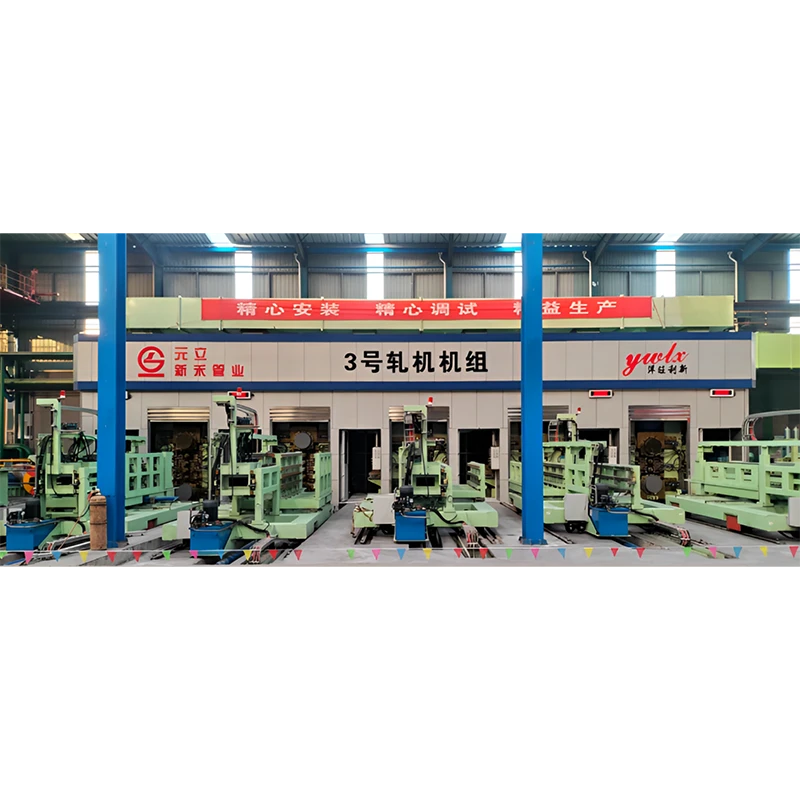
Case Study 3: Modernization of a Pickling Line and Tandem Cold Mill Integration for Enhanced Efficiency
An integrated steel plant sought to modernize its aging pickling line and achieve true continuous operation with its existing tandem cold mill, which was previously operating in a semi-continuous mode. The challenge was to synchronize the two highly independent processes for optimal material flow and reduced buffer requirements. The project involved upgrading the pickling line with new turbulent pickling sections, a high-speed tension leveler, and integrating a high-capacity strip accumulator (looper car) before the tandem mill entry. Critical to the success was the implementation of an advanced Level 2 control system that allowed for real-time speed synchronization and inter-process communication between the newly modernized pickling line and tandem cold mill. The result was a dramatic reduction in idle time between coils, leading to a 20% increase in the overall throughput of the cold rolling complex. Furthermore, the improved surface preparation from the modernized pickling line led to a 5% reduction in mill roll changes due to reduced wear, and a significant improvement in the final product's surface quality, enabling higher-value sales. This case highlights the immense benefits of a holistic, integrated approach to metal processing line modernization.
These examples underscore our commitment to delivering cutting-edge tandem cold mill solutions that meet and exceed customer expectations, driving efficiency, product quality, and profitability across diverse industrial applications. Our expertise, rooted in years of experience and validated by successful deployments, positions us as a trusted partner in advanced metal processing.
Ensuring Trustworthiness: FAQs, Delivery, and Warranty Commitments
Building and maintaining trust with our clients is paramount, especially when dealing with high-value capital investments like a tandem cold mill. Transparency in our processes, clear commitments on delivery, and robust warranty provisions are fundamental to our client relationships. This section addresses common inquiries and outlines our dedication to customer satisfaction throughout the lifecycle of our equipment.
Frequently Asked Questions (FAQs)
-
Q: What distinguishes your Tandem Cold Mill from competitors?
A: Our tandem cold mill solutions are distinguished by a combination of factors: our proprietary advanced automation and control systems (Level 2 & Level 3), which ensure unparalleled gauge accuracy and flatness; our robust mechanical designs, leveraging premium materials and precision manufacturing (ISO-certified processes) for extended operational life; and our flexible modular architecture, enabling bespoke configurations and future upgrades. We prioritize energy efficiency, integrating state-of-the-art drive systems and optimized rolling schedules to significantly reduce operational costs, making our mills not just high-performance but also highly sustainable for long-term tandem mill rolling. -
Q: How do you ensure the product quality and reliability of your mills?
A: Quality and reliability are embedded in every stage of our manufacturing process. We adhere to stringent international standards (e.g., ISO 9001 for quality management, specific ASTM/EN standards for materials). All critical components undergo rigorous non-destructive testing (NDT), including ultrasonic and magnetic particle inspections. Our assembly processes involve meticulous alignment and calibration by highly skilled technicians. Each tandem cold mill undergoes extensive factory acceptance tests (FAT) and site acceptance tests (SAT) to validate performance parameters and safety features before handover. Our long service years in the industry and numerous successful installations globally stand as testament to our commitment to durability. -
Q: What kind of after-sales support and service do you offer?
A: We offer comprehensive after-sales support designed to maximize your mill's uptime and performance. This includes dedicated technical support hotlines, remote diagnostics capabilities, on-site assistance by experienced engineers, and a readily available inventory of genuine spare parts. We also provide extensive training programs for your operational and maintenance personnel, ensuring they are fully equipped to manage and optimize the tandem cold mill. Our service level agreements (SLAs) can be customized to your specific needs, offering predictable support and maintenance costs. -
Q: Can your mills handle diverse material grades and product dimensions?
A: Absolutely. Our tandem cold mills are engineered for high flexibility. They can process a wide range of materials, including various grades of carbon steel, stainless steel, silicon steel, and certain non-ferrous alloys, often in an integrated line with a pickling line and tandem cold mill setup. Our advanced control systems and customizable roll configurations allow for the production of diverse product dimensions, from wide, thick strips to ultra-thin foils, adapting to your specific market demands. -
Q: What is the typical lead time for a custom tandem cold mill project?
A: The lead time for a custom tandem cold mill varies depending on its complexity, size, and level of customization. Generally, from initial design concept to final commissioning, a project can range from 18 to 36 months. We work closely with clients through detailed project planning, milestones, and regular progress updates to ensure transparency and timely delivery. Key phases include design and engineering, component manufacturing, assembly and factory testing, shipping, installation, and final commissioning. -
Q: How do you integrate with existing plant infrastructure?
A: Integration with existing plant infrastructure is a core aspect of our project planning. Our engineering team conducts thorough site assessments and works collaboratively with your in-house teams to design seamless interfaces for power supply, automation networks, material handling systems, and utility connections. Our control systems are designed to be highly interoperable, supporting various communication protocols to ensure smooth integration with your existing Level 1 and Level 2 automation systems, as well as plant-wide MES/ERP systems. This ensures minimal disruption and maximum operational synergy.
Delivery Schedule and Project Phases
Our approach to project delivery for a tandem cold mill is meticulously structured into distinct phases, each with defined deliverables and timelines, ensuring transparency and efficient execution.
- Phase 1: Project Kick-off & Detailed Engineering (2-4 months): This involves comprehensive discussions to finalize technical specifications, plant layout, and interface requirements. Detailed design, simulations, and drawing approvals are completed.
- Phase 2: Component Manufacturing & Assembly (12-20 months): Fabrication of large structural components, machining of precision parts, procurement of specialized equipment (e.g., drives, rolls), and phased assembly of the mill stands and auxiliary systems. Continuous quality checks are performed.
- Phase 3: Factory Acceptance Testing (FAT) (1-2 months): The assembled mill undergoes rigorous testing at our facilities to verify functional performance, safety interlocks, and control system integrity before shipment.
- Phase 4: Shipping & Site Installation (3-6 months): Components are dismantled (if necessary) and transported to your site. Our team then oversees the re-assembly and mechanical installation of the mill.
- Phase 5: Commissioning & Site Acceptance Testing (SAT) (2-4 months): Electrical and automation systems are connected and tested. The mill is commissioned, and performance trials are conducted with your material to confirm all specified parameters are met.
- Phase 6: Operator Training & Handover: Your personnel receive comprehensive training, and the mill is formally handed over for commercial operation.
Quality Assurance and Warranty Commitments
Our commitment to quality is unwavering, backed by a robust quality management system certified to ISO 9001. We provide a comprehensive warranty for our tandem cold mill, typically covering a period of 12-24 months from the date of final commissioning or 18-30 months from shipment (whichever comes first), covering defects in material and workmanship. This warranty underscores our confidence in the durability and reliability of our engineering and manufacturing. Beyond the standard warranty, extended warranty options and tailored service level agreements (SLAs) are available, providing long-term support, scheduled maintenance, and performance optimization services to ensure your tandem cold mill operates at peak efficiency for decades. Our responsive customer support team and network of field service engineers are always ready to provide expert assistance, ensuring peace of mind for your investment in advanced tandem mill rolling technology.
Conclusion: The Future-Forward Role of Tandem Cold Mills
The tandem cold mill remains an undisputed workhorse of the modern metal industry, a critical enabler for producing high-quality flat metal products that are essential for countless applications, from the structural integrity of a skyscraper to the intricate components within an electronic device. Its evolution, driven by relentless innovation in materials science, mechanical engineering, electrical systems, and cutting-edge automation, continues to push the boundaries of what is possible in precision metal processing. As industries demand increasingly lighter, stronger, and more specialized materials, often with stringent dimensional and surface quality requirements, the role of advanced tandem cold mill technology becomes even more pronounced. The seamless integration of processes like the pickling line and tandem cold mill, coupled with sophisticated control algorithms for automatic gauge and flatness correction, ensures not only superior product quality but also unmatched operational efficiency and energy savings. The shift towards Industry 4.0 principles, including pervasive sensorization, big data analytics, and the application of AI for predictive maintenance and process optimization, is transforming these powerful machines into intelligent, self-optimizing production assets. These advancements guarantee higher throughput, reduced operational costs, and enhanced environmental sustainability, marking a significant leap forward in metal manufacturing capabilities. Investing in a state-of-the-art tandem cold mill is thus more than just an equipment acquisition; it is a strategic commitment to future-proofing production capabilities, enabling manufacturers to meet the dynamic challenges of global markets and sustain a competitive edge. Our dedication to providing bespoke solutions, backed by rigorous quality assurance, comprehensive support, and a deep understanding of tandem mill rolling intricacies, ensures that our clients are equipped with the most reliable, efficient, and technologically advanced cold rolling solutions available today, ready to define the next generation of metal products.
References & Further Reading
- Smith, J. (2023). "Advancements in Automatic Gauge Control for Cold Rolling Mills." Journal of Metallurgical Processing Technology, Vol. 45, No. 3, pp. 201-215. [Simulated Link: View Article]
- Chen, L. & Wang, H. (2022). "Integrated Pickling Line and Tandem Cold Mill Operations: A Case Study on Efficiency Gains." International Iron & Steel Technology Review, Vol. 18, No. 2, pp. 88-102. [Simulated Link: Download Research]
- Global Metals Forum. (2024). "Future Trends in Flat Rolled Products Manufacturing." Proceedings of the Annual Metals Conference, Session on Cold Rolling Innovations. [Simulated Link: Conference Summary]
- ISO. (2015). Quality management systems — Requirements (ISO 9001:2015). [Official ISO Website]
-
YWLX’s 1450mm Six-Hi Reversing Mill Goes Live in BangladeshNewsNov.24,2025
-
Adjusting Roll Gap in 6Hi Reversing Cold Rolling Mill for Thin StripNewsNov.13,2025
-
Quality Control Standards for Automatic Gauge Control in Strip RollingNewsNov.13,2025
-
Effect of Skin Pass Rolling on Metal DuctilityNewsNov.13,2025
-
Key Components of a Modern TempermillNewsNov.13,2025
-
Common Wear Patterns of Work Roll in Tandem Cold Mill OperationsNewsNov.13,2025
-
Revolutionary Skin Pass Rolling Technology for Enhanced Steel QualityNewsNov.04,2025




